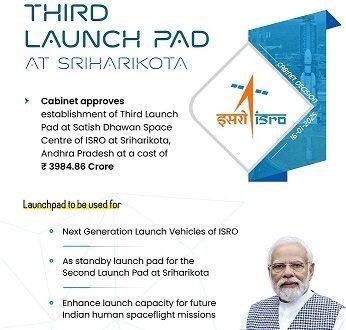Union Cabinet Approves Third Launch Pad at Sriharikota
Why in the news?
The Union Cabinet has approved the construction of a third launch pad at Sriharikota, with a ₹3,984.86 crore budget. The new pad will support ISRO’s future launch vehicles and Indian manned space missions, enhancing capabilities.
Approval and Budget Details:
- The Union Cabinet approved the construction of a third launch pad at the Satish Dhawan Space Centre (SDSC) in Sriharikota.
- The new launch pad will have a budget of ₹3,984.86 crore and is expected to be completed by early 2029.
- This approval is aimed at supporting ISRO’s Next Generation Launch Vehicles (NGLVs), set to begin operations in 2031.
Purpose and Design of the Launch Pad
- The third launch pad will be designed to handle heavier-class launch vehicles, such as NGLVs and Launch Vehicle Mark 3 with semicryogenic stages.
- It will also serve as a standby for the first two launch pads at Sriharikota, which have been operational for nearly two decades.
- The pad is envisioned to be universal and adaptable, ensuring it supports future space transportation requirements for the next 25-30 years.
Support for Space Missions
- The new launch pad will assist in Indian manned spaceflight missions, with ISRO targeting its first mission in 2026.
- It will strengthen ISRO’s launch capabilities and capacity to cater to evolving space technology demands.
- The establishment of the third pad is crucial to ISRO’s future missions, enhancing its capacity to handle larger and more complex space vehicles.
About TLP (Third Launch Pad) Features & Significance:
- Supports: Launch of NGLV and LVM3 vehicles with semi-cryogenic stage.
- Integration: Supports horizontal and tilted integration of new NGLVs.
- Significance: Increases launch frequency, enhances capacity for human spaceflight and space exploration missions.
Existing Launch Pads:
- FLP: Supports PSLV and SSLV.
- SLP: Supports GSLV, LVM3, and acts as a standby for PSLV.
New Generation Launch Vehicles (NGLV) Program:
- Features: 3-stage vehicle with reusable first stage, semi-cryogenic propulsion.
- Payload: 3 times the current capacity, at 1.5 times the cost of LVM3.
Sources Referred:
PIB, The Hindu, Indian Express, Hindustan Times




